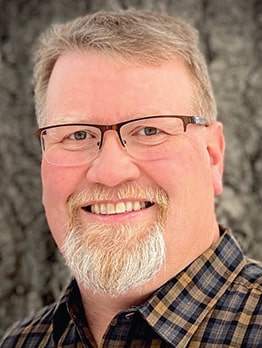Soil sampling as step toward improved land use
Dean Nelson has areas within fields that he knows should be treated differently when it comes to fertilizer management. Nelson from Wetaskiwin, Alberta has been farming since 1996 and he always keeps records of fertilizer rates.

Dean Nelson works through his local Federated Co-op Agro Centre to have his acres counted under Fertilizer Canada’s 4R Nutrient Stewardship program.
“I’m always taking soil samples, and then putting on the right rate of fertilizer for each field,” Nelson says. “This has saved me a lot of money over the years.”
But he sees potential in taking this to another level. He has fields with black soils, sandy soils and areas with solonetzic hardpan just below the soil surface. These field characteristics can mean fairly high variability in yield potential and fertilizer return on investment, especially the solonetzic areas that limit water infiltration and tend to be higher in salinity.
Nelson is not set up for automated variable-rate application of nutrients, but he will look at low-tech methods to provide special treatment for these zones.
“I want to sample the solonetzic areas separately, and compare them to the rest of the field, checking for variances,” he says. With that information, he could manually cut fertilizer applications to those larger areas or target them for manure to improve soil quality.
Moving toward fertilizer rates adjusted for in-field variability represents the second tier of 4R nutrient management, which is a central part of Nelson’s field management plan. In fact, Nelson works through his local Federated Co-op Agro Centre to have his acres counted under Fertilizer Canada’s 4R Nutrient Stewardship program. (See the sidebar.)
Nelson started this back when Wetaskiwin Co-op was owned by Parkland Fertilizers. Parkland offered a program for its farmers as a way to recognize their sustainability practices. Farmers could then use this label when selling to end users. “As farmers, we were doing everything right but weren’t being recognized for it, so I signed up,” Nelson says. “I felt that if the program could help customers recognize that farmers are doing the right thing, it would help agriculture in the long run.”
When Co-op took over the Wetaskiwin location, it was a relatively easy step for Nelson to transfer over to Co-op’s own “Grown with Purpose” program. Co-op started Grown with Purpose in 2019 to demonstrate the good news story of agriculture throughout its value chain. Co-op is aligned with Fertilizer Canada’s 4R Nutrient Stewardship program.
Robyn Gerrard, an agronomist at Wetaskiwin Co-op, has the 4R designation, which allows her to work with farmers to have their acres recognized as 4R. “All of the agronomists in our office have the designation, and I think most agronomists who work for Federated Co-op have it,” she says.
She has no trouble getting farm acres signed up under the program. “Farmers in this area are modern and up-to-date, so the basic principles of 4R – minimum tillage, soil sampling and using new more efficient fertilizer sources – are already widely accepted,” Gerrard says.
Nelson is one of her farmers. He says it takes a five- to 10-minute conversation with Gerrard to get signed up each year. The process is simple because, as he says, he uses minimum tillage, he soil tests every year, and he uses a different blend for each field.
While there’s no premium price for those who participate – “I haven’t seen any price benefit for it,” Nelson says – having acres recognized as 4R has other benefits.
“Being able to show the landlord that you’re taking good care of the land is important, especially in the Wetaskiwin area.”
“It can improve your personal brand,” Gerrard says. For one thing, this can make it easier to negotiation land rental agreements. “Being able to show the landlord that you’re taking good care of the land is important, especially in the Wetaskiwin area.”
Working with Gerrard to stay on top of 4R practices can also improve Nelson’s fertilizer return on investment. He gives the specific example of soil sampling after a recent drought year. “My soil samples showed more nutrients left in the soil than I expected, so I reduced my fertilizer rates by half the following year.”
Overall, Nelson says following 4R practices, having regular 4R conversations with Gerrard and then seeing his acres recognized as 4R are all worthwhile steps. “It’s good to try and improve my farm to the best of my ability. We don’t always do the best, but we learn from our mistakes and go forward.”
Two quiz questions on soil sampling
The Canola Watch agronomy quiz for October 7, 2020 had these two questions:
1. Roughly how much will it cost per field to (1) hire someone to collect a composite sample in two parts (0-6″ and 6-24″) and (2) get a lab analysis on that two-part soil sample?
A. Around $50
B. $100 to $200
C. $300 to $400
D. Around $500
2. The Saskatchewan Crop Planning Guide for 2020 has estimates for input costs. For the Black Soil Zone, the guide uses a base canola yield of 53.8 bu./ac. and estimates fertilizer costs per acre based on nutrient removal for that crop. What does the guide suggest will be the total fertilizer cost per acre for this canola yield?
A. $68
B. $81
C. $93
D. $117
Answers: 1 (B) and 2 (C). A soil test cost of $1 (or less) per acre makes a lot of sense if it helps make better decisions on a fertilizer bill of $93 (or so) per acre.
See this quiz and others at canolawatch.org. While there, sign up to receive agronomy updates (including the quick agronomy quizzes) through the year.
For tips on soil sampling and fertilizer rates for canola, see the Fertility section at canolaencyclopedia.ca.





